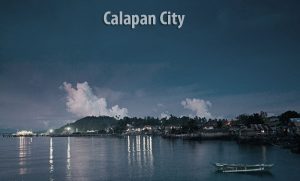
History
Calapan City was just a small village before the establishment of the first Religious District in Bago. The District convent was transferred to Calapan in 1733 and began its jurisdiction over the Northern Mindoro Ecclesiastical Area. In the early 18th century, the town only occupied a strip of land stretching from Ibaba to ilaya in a cross-shape facing the present church and cut-off by the river. Later on, succeeding barrios were established.
In 1836, the capital of the province was moved from Puerto Galera to Calapan. When Mindoro became a part of Marinduque on June 13, 1902, the provincial capital was once moved to Puerto Galera. On November 10, 1902, Mindoro was detached from Marinduque. In 1903, Calapan once againn became the provincial capital.
When Mindoro was detached to Marinduque on November 10, 1902, Baco, Puerto Galera and San Teodoro were annexed to Calapan in 1905 under Act. 1280, adding a total land area of 843 square kilometers (325 sq mi) of land. In 1902, under Act 2824, the three municipalities gained their independence.
 In 1919, the boundary dispute between Calapan and Naujan was adjudicated by Presidentes Agustin Quijano of Calapan and Agustin Garong of Naujan over a portion of the territory of what is now known as the present boundary. The portion of agricultural area was awarded to Naujan, thus, making the area of Calapan much smaller as compared to that of Naujan which is now considered as the biggest municipality of the province.
In 1919, the boundary dispute between Calapan and Naujan was adjudicated by Presidentes Agustin Quijano of Calapan and Agustin Garong of Naujan over a portion of the territory of what is now known as the present boundary. The portion of agricultural area was awarded to Naujan, thus, making the area of Calapan much smaller as compared to that of Naujan which is now considered as the biggest municipality of the province.
At present, Calapan has an area of only 250.06 square kilometres (96.55 sq mi), according to LMB. It has also jurisdiction over the three Baco Islets on the Calapan Bay and the two Silonay Islets.
Population/ Language/ Area
Total population of the city as of 2010 is 124,173.
Land area, ranging up to 250.06 km2 (96.55 sq mi), is mainly consist of rural areas.
Products and Services
Main economic activities are agriculture and trading. Products manufactured include processed food and handicrafts. Infrastructure facilities include the Calapan Port and a secondary airport. Major roads include Quezon Boulevard which leads to the seaport and airpot, Jose Rizal Street, Roxas Drive, and Bonifacio Drive.
Business Opportunity
As one of the primary RO-RO ports of the Strong Republic Nautical Highway and being the largest urban center of the whole Mindoro Island, Calapan City has the potential for the development of small and big businesses. It offers opportunities in real estate, tourist facilities, agri-business, manufacturing, trading, and services such as schools, hospitals, and technology related ventures.
Tourist Spots
- Balite, Parang, and Suqui Beaches
- Baco-Chico and Horca-Piloto Islets with white sand beaches
- Bulusan Nature Park and Cave
- Halhal Cave
- Caluwangan Cave
- Rizal Park
- Holy Infant Cathedral
- Silonay Island
Festivals and Celebrations
- Kalap Festival – celebrated every 21st day of March. This is a celebration of culture and history. There are floats along the main streets detailing the history of the city.
- Sto. Niño de Calapan Festival – this religious festival is held every January 1. This is actually a month-long celebration starting as early as December until it reaches its pinnacle through a series of different religious activities to honor the city’s patron, the young child Sto. Niño and to reflect the people’s religiosity. The celebration extends towards the Christmas season laced with nightly cultural presenations, yuletide activities topped by the lighting of the giant Christmas tree and fireworks,a s well as agro-industrial and tourism fairs.
- Harvest Festival – this festival was conceptualize by the city government council in recognition of Calapan City’s achievement as one of the major exporter of rice in the Philippines. The city was once an importer of rice but now rice is the most important export of Calapan.
- Sinkaw Festival – derives from the word “sining kalabaw” or carabao arts, this festival is a creative artistic competition with no less than the carabaos are used as the canvasses. This festival honors the city’s native “beast of the burden” as an eternally indispensable partner in farming and, essentially, a special tribute to the farmer’s industry.
- Mardigras – held on many different occasions (fiesta, summer, Foundation Day, Halloween) that add more color to the already vibrant city. It is ultimate street party that takes place along the entire stretch of J.P. Rizal Street. The hypnotic lights and upbeat music, together with various fun-filled activities, will bring together a bevy of party-goers to party the night away.
